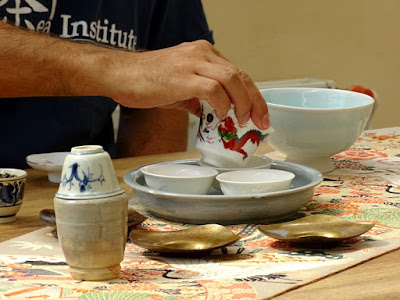The participants wondered why I don't use a gongdao bei or cha hai or pitcher during this training.
A pitcher is a practical accessory that makes preparing tea more convenient:
- No need to wait for everybody's cup to be empty and back next to the brewer to make the next brew,
- It's easy to empty your gaiwan or teapot in the pitcher,
- Everybody receives the same concentration level of tea from the pitcher.
However, a pitcher also has some drawbacks that make it unsuitable if you wish to pursue the path toward tea perfection. Here is why:
1. Scents. Every time you pour a hot liquid into another vessel, the temperature of the liquid drops a few degrees. Therefore, if you pour tea into a pitcher and then into the cups, it will be cooler than if you pour directly into the cups. This matters, because the hotter the tea, the more scents it releases.
2. Simplicity. Get rid of what's superfluous on the tea table. With a pitcher, you need 2 steps to pour in the cups. Without, you only need one step. That's why there were no pitchers in the traditional Chaozhou gongfu cha.
3. Skill. Gongfu cha means 'skilled' tea. One of the skills of gongfu cha is pouring the tea into the cups. With a pitcher there's not much skill involved. Pouring directly into the cups without spilling tea requires a good technique, experience and attention. At the same time, you must also make sure you share the tea evenly between the cups. The proper way to do that is to partially fill 3 cups in this order: 1 half - 2 half - 3 full - 2 half - 1 half so that the cups receive the same tea concentration.
4. Flexibility. In theory, we aim at achieving the same tea concentration for all the drinkers. But if one of them likes it lighter than the others, then pouring directly in the cups allows us the possibility to pour different levels of concentration. In order to take this person's taste into account, I would pour 1 full - 2 half- 3 full - 2 half and give cup number 1 to the person who likes its tea light.
5. Focus. Trying you best to minimize the water/tea you spill while averaging the concentration and volume in the cups requires your full attention and a steady hand. It forces us to calm down and this also benefits the other aspects of the brewing (hot water pouring, feeling when the tea is ready, tea appreciation...).
When I manage not to spill any tea outside the cups, I am often rewarded with a sense of flow, a beautiful sensation of harmony. And the tea from these cups feels particularly good. This is how tea gives you a direct feedback on your state of mind.
This full day of Oolong brewing went really well and we finished it with my 2001 Concubine Oolong from Yong Lung (Dong Ding).
This was a perfect tea to share and to mark this special occasion that brought us together in this Prag winter garden. Thanks again to all the participants and to Zdenek for his very kind hospitality.
Thanks also to Dzin TeaRacer for all the pictures where I'm on.
































